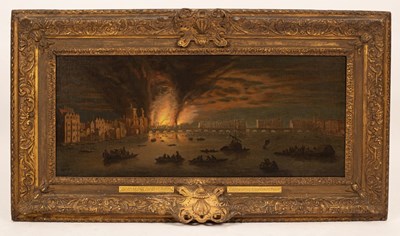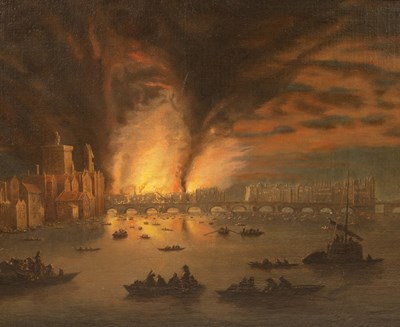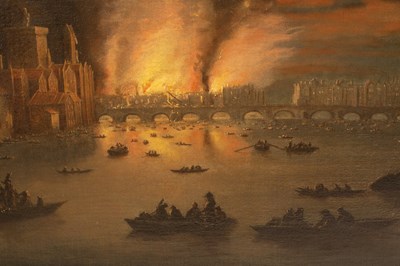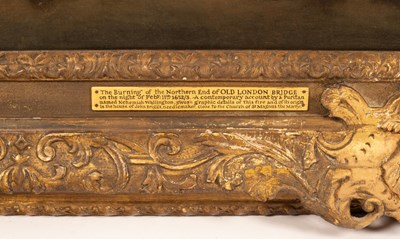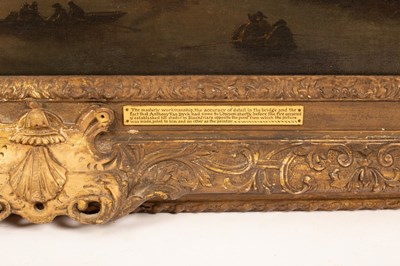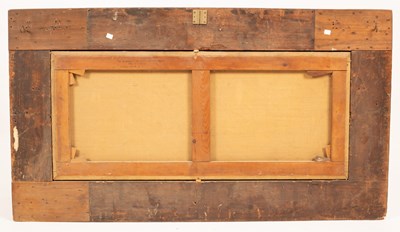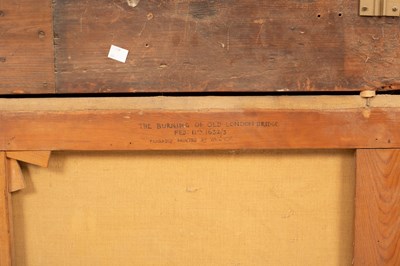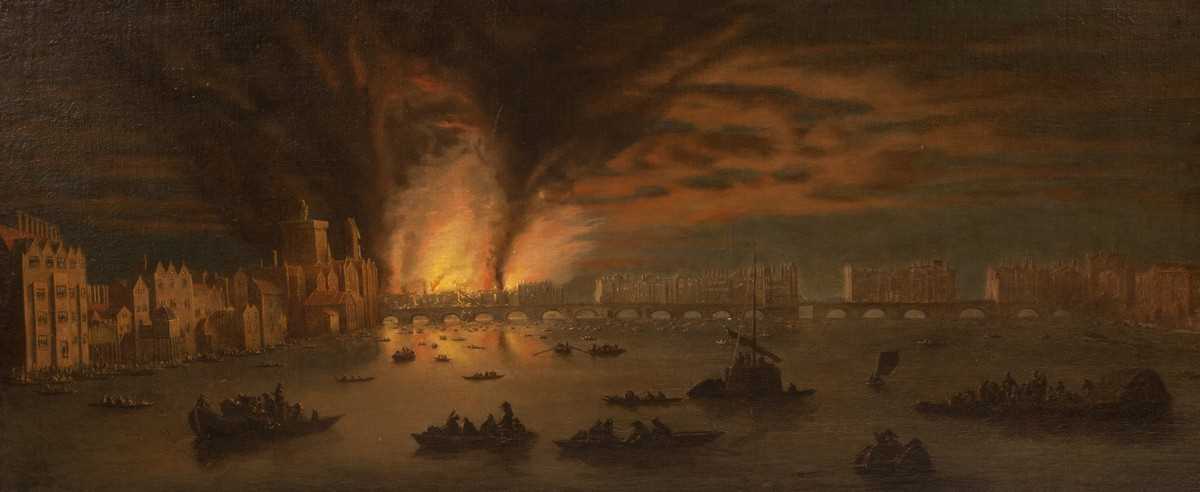27th Jun, 2023 10:00
Fine Jewellery & Old Master Paintings
340
English School, late 17th Century/The Burning of London Bridge, 1632/oil on canvas, 45.5cm x 110cm/Note: Purchased by Gordon Home and thence by bequest/The Estate of the late Diana & Gospatric Home, Lily Farm, Bucks. The painting has been variously attributed to Canaletto, Van Dyck and Van Wyck (1645-1702). A Flemish hand has been suggested based on the artistic style and there were certainly Flemish artists in London, e.g. Alexander Kerrinck, Claude de Jongh and Van Dyck. The architectural features of the Bridge and the costumes of the figures in the boats have been noted as correct for the year 1633./The frame with two plaques reading: ''The Burning of the Northern end of Old London Bridge on the night of February 11th 1632-3. A contemporary account by a Puritan named Nehemiah Wallington give graphic details of this fire and of its origin in the house of John Briggs, needle maker. Close to the church of St Magnus the Martyr. The masterly workmanship, accuracy of details in the bridge and the fact that Anthony Van Dyck had come to London shortly before the fire occurred established his studio in Blackfriars opposite the point from which the picture was made, point to him and no other as the painter.''/The Home family had a close connection with London Bridge and the historian and illustrator Gordon Home published a book on 'Old London Bridge' in 1931./The painting depicts not the Great Fire of London from 1666 but the earlier event of 1632 during which much of the bridge was destroyed. Included are insurance papers for the painting as well as correspondence between Gordon Home and others regarding the painting, showing that it had been loaned for an exhibition at the Guildhall Art Gallery and relined by the 'Collectors' Picture Restoring Company, Chelsea. Also included is a volume of 'Old London Bridge: Lost and Found by Bruce Watson for English Heritage and the Museum of London in which the painting is illustrated. Further included is a handwritten essay by Gordon Home on the painting which describes the discovery and restoration of the painting by W. Arthur Crossland as well as various conjectures on the artist.
Sold for £9,000
English School, late 17th Century/The Burning of London Bridge, 1632/oil on canvas, 45.5cm x 110cm/Note: Purchased by Gordon Home and thence by bequest/The Estate of the late Diana & Gospatric Home, Lily Farm, Bucks. The painting has been variously attributed to Canaletto, Van Dyck and Van Wyck (1645-1702). A Flemish hand has been suggested based on the artistic style and there were certainly Flemish artists in London, e.g. Alexander Kerrinck, Claude de Jongh and Van Dyck. The architectural features of the Bridge and the costumes of the figures in the boats have been noted as correct for the year 1633./The frame with two plaques reading: ''The Burning of the Northern end of Old London Bridge on the night of February 11th 1632-3. A contemporary account by a Puritan named Nehemiah Wallington give graphic details of this fire and of its origin in the house of John Briggs, needle maker. Close to the church of St Magnus the Martyr. The masterly workmanship, accuracy of details in the bridge and the fact that Anthony Van Dyck had come to London shortly before the fire occurred established his studio in Blackfriars opposite the point from which the picture was made, point to him and no other as the painter.''/The Home family had a close connection with London Bridge and the historian and illustrator Gordon Home published a book on 'Old London Bridge' in 1931./The painting depicts not the Great Fire of London from 1666 but the earlier event of 1632 during which much of the bridge was destroyed. Included are insurance papers for the painting as well as correspondence between Gordon Home and others regarding the painting, showing that it had been loaned for an exhibition at the Guildhall Art Gallery and relined by the 'Collectors' Picture Restoring Company, Chelsea. Also included is a volume of 'Old London Bridge: Lost and Found by Bruce Watson for English Heritage and the Museum of London in which the painting is illustrated. Further included is a handwritten essay by Gordon Home on the painting which describes the discovery and restoration of the painting by W. Arthur Crossland as well as various conjectures on the artist.
Auction: Fine Jewellery & Old Master Paintings, 27th Jun, 2023

